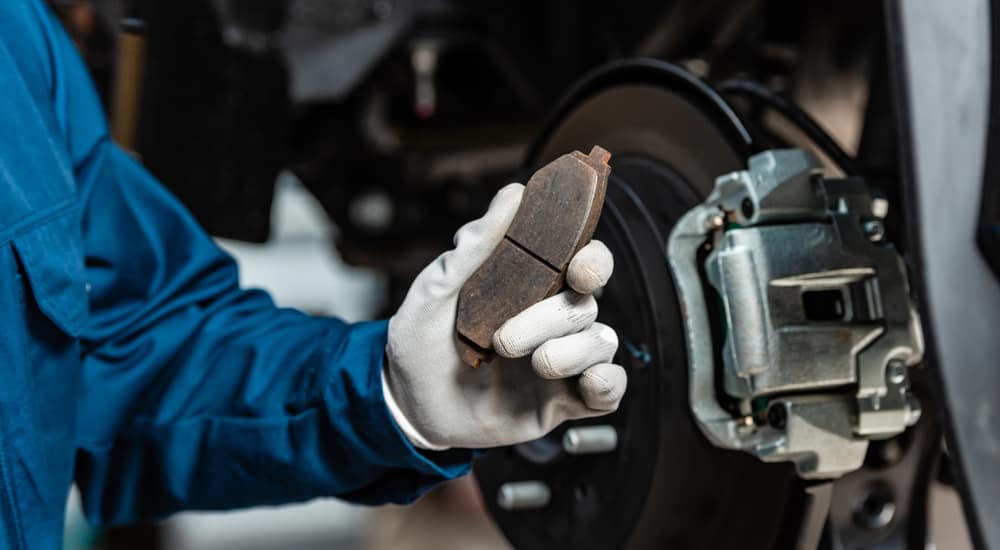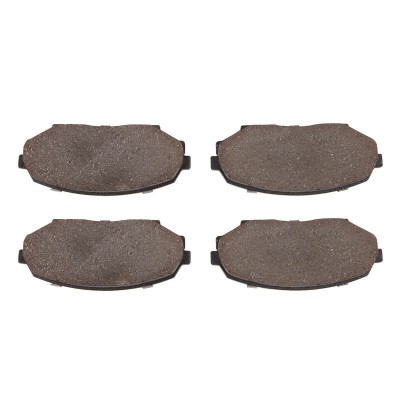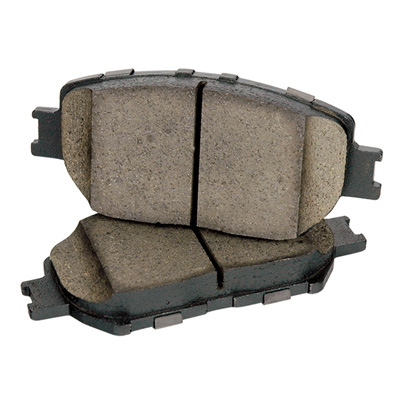
The brake pads might just be the most important part of your vehicle braking system. We say that because no one can realistically drive a car without proper brake pads.
Table of Contents
You can find the brake pads inside disc brakes, where they work with the caliper and rotor to help the car come to a halt when you want it to. Their function is pretty simple: they essentially grab the disc and keep it from rotating to stop the car. Since these components work when the vehicles are driven at top speeds, they must withstand friction. Unfortunately, this is why brake pads start to wear. Eventually, you need a new brake pad to ensure the continued integrity of your braking system.
There are several different types of brake pads, each with its unique qualities. One of the most popular options is ceramic brake pads. This article will serve as a guide on everything you need to know about this and other types of brake pads. We will answer how long do ceramic brake pads last and break down the life-span of other types of brake pads.
Let's get started.
What Are The Different Types Of Brake Pads?
Mainly four types of brake pads are available in the market. We will talk about each of them in detail.
Semi-Metallic
As the name suggests, it is made from 30% to 65% metal. This type of brake pad is very durable and offers excellent braking for your vehicle.
These are also generally cheaper than other options, such as ceramic pads. The semi-metallic brake pads excel in performance and cost, but they lack resistance and comfort. In addition, these brake pads are not fit to withstand extremely low temperatures and are often loud compared to other types. All in all, these brake pads work best on high-performance vehicles such as race cars.
Low-Metallic, Non-Asbestos Organic (NAO)
The next type of brake pad readily available in the market is low-metallic, non-asbestos organic. This option is great if you want the heat transfer and better braking with a copper or steel build. It is also an inexpensive option and offers durability.
That being said, these brake pads can be noisy and also release a lot of brake dust that causes pollution.
Non-Asbestos Organic
We have talked about the noisy brake pads, so what could be an alternative? The next option available in the market is the non-asbestos organic brake pad. Like the one discussed before, these brake pads are made from organic materials such as glass, fiber kevlar, and rubber instead of copper and steel.
NAOs are inexpensive and quiet, but they do not have the same durability as their metallic alternative. In addition to letting off brake dust, NAO brake pads wear and tear quite frequently, forcing you to replace brake pads often.
Ceramic
Finally, we have the most popular option. Ceramic brake pads solve all the problems that other types don't. They are durable, quiet, relatively dust-free, and suitable for most vehicles. The only drawback is its cost. Ceramic brake pads are considerably more expensive than others. Still, it is a fair enough trade due to their longevity.
Moreover, ceramic brake pads are much softer and more consistent than the competition. And you can use them on pretty much any vehicle and luxury car except for glamorous supercars or industrial vehicles.

How Long Do Brake Pads Last?
Once you choose the type of brake pad you want in your car based on the requirement, the next question is how long do these brake pads last and when you should replace them. Most brake pads have a lifespan of 30,000 to 70,000 miles. However, certain factors play a part in their durability, and some brake pads can even last up to 100,000 miles.
Depending on the composition of the brake pad and the maintenance, the lifespan may vary. You can expect to run most brake pads up to 30,000 miles, after which you can get a quick inspection to assess the wear. Be sure to use brake fluid after every 25,000 miles to prolong the life of the braking system.
How Long Do Ceramic Brake Pads Last?
Ceramic brake pads tend to be more expensive, so they are considered premium and are usually found in luxury cars.
They are expensive but make up for the hefty price tag with their durability. Moreover, they can last you up to 75,000 miles if properly maintained. Of course, the driving style does play a huge factor in their longevity. Still, overall these brakes last the longest as compared to the alternatives.
The only issue with carbon-ceramic brake pads is that they aren't suitable for high-performing cars but can easily give you up to 80,000 miles before they need to be replaced. So, even though they are priced steeply, the investment is more than worth it because they last you a long time, costing you less in the long run.
How To Know If I Need New Ceramic Brake Pads?
Getting a brake pad replaced at the right time is necessary for the car's health and the driver's safety. Most people do not keep track of their miles when they get new brake pads. These signs indicate your brake pads need to be replaced:
1. You will hear a squealing or screeching sound every time you press the brake. This is because the pads have worn off, and the metal backing plate of the brake pad is rubbing against the steel, making this sound. This metal backing plate is made for this sole purpose to alert the driver that it is time for replacement
2. If you open up your wheel to visually inspect the brake pad, the friction material should be thicker than a quarter of an inch. Anything less than that, and you need to replace your brake pad before it starts damaging the entire braking system
3. If you hear a deep metallic sound, you need to go to the mechanic to get your brake pad replaced today. This is because the backing metal of the brake pad rubbing against your disc brake can cause severe damage to your car
4. The easiest way to know when to change brake pads is through the indicator light. Certain cars have an indicator light that clearly shows when the brake pads need to be replaced.

How Much Do Ceramic Brake Pads Cost?
A significant drawback of a ceramic brake pad is the cost. While you can get a semi-metallic or organic brake pad between $30 and $50, a ceramic brake pad can cost you anywhere from $3,000 up to $15,000. This is not even considering labor costs. One of the most expensive brake pads you can get is the Porsche Ceramic Composite Brake (PCCB) which can set you back $21,000.
Ceramic brake pads are almost 100 times more expensive because they require special care and expertise during manufacturing. It takes a lot more effort and time to produce a ceramic composite brake disc, while iron and steel brake discs can easily be melted and shaped to the requirements.
The manufacturing process for ceramic brake pads is tedious. Still, it makes for high-quality brakes that can last you a long time while keeping your entire brake system healthy.
Why Should You Choose Ceramic Brake Pads?
While expensive, ceramic brake pads have several advantages of fitting a ceramic brake pad in your car. These advantages include:
• Little to no noise: Brake pads made from ceramic composite are quiet and produce no extra sound when the brake is applied. This is not the case for semi-metallic brake pads that make a loud noise every time you apply the brake
• No brake dust: The biggest issue with NAO and organic brake pads is the brake dust it produces. Ceramic-composite brake pads produce less brake dust as they wear down
• Superior quality: Compared to semi-metallic and NAO brake pads, ceramic brakes are more reliable in a wider range of driving conditions and can withstand extreme temperatures
• Durability: Ceramic brake pads offer almost twice the durability of organic brake pads cutting down your visits to the mechanic
Wrapping Up
Brake pads come in several types to suit different types of vehicles. Depending on what you want from your brake pad, there are several options to choose from. Among them, ceramic brake pads are the most reliable and convenient option if you are ready to spend a little extra.
These brake pads not only offer high durability, saving you from recurring labor costs but also offer a premium feel when driving, protecting your entire brake system.
Just be sure to check your new brake pads before installing them to ensure they have the right thickness and there is no wear and tear in the friction plate. Furthermore, be sure to have your brake pads fitted by a professional. A bad installation can cause the brake pad to lose its ability to perform optimally and damage the disc brake system.
